Distinguished Critique: Elseworlds: Batman (vol. 2) Review
Though occasionally verbose, this terrifying trilogy casts our Batman in a morally amibiguous, blood-thirsty mold, internal torture superseding external conflict
—by Nathan on September 12, 2025—
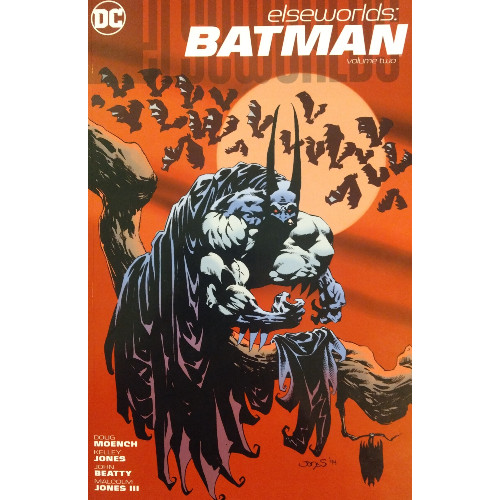
It had to happen eventually.
Someone, at some point, had to write a story where Batman–a dude who dresses like a creature of the night and has a cape which appears like leathery wings–became an actual vampire. The idea is too good and too obvious to go untouched forever. And with the advent of DC's Elseworlds imprint, Doug Moench and Kelley Jones were elected as the guys to tell that tale.
The "Batman: Vampire" stories, as they are called, are a trilogy of tales told over seven years, the first being one of the earliest Elseworlds comics. As Elseworlds stories themselves state, the characters you know and love (or hate) are taken and twisted, pressed into new molds, sent into new worlds and times, made different from how we know them. Maybe it's Superman fighting in the Civil War or landing in the Soviet Union instead of America, or Batman facing Jack the Ripper, or Superman and Batman aging across the decades. Whatever the change, it's a new take on old ideas, meant to shock and inspire the imagination. I'd call them "What If-?"s, but we already know who has the trademark on that.
In this taut trilogy of horror, Moench and Jones definitively answer a question I bet nobody has ever asked before: does Bruce Wayne more closely resemble a fruit bat or a "bite you and drink your blood" bat? The answer is absolutely the latter, especially after Batman has a run-in with the Lord of Vampires himself, Dracula. Gothic horror comes to Gotham, draped under the shadows of dark nights, Dark Knights, dark capes, and dark wings.
You may notice that, though this is the second volume collecting Batman's Elseworlds adventures, there is no review on this site for the first volume. I own the inaugural volume, gathering the first Batman Elseworlds stories, though I'll admit to not having reviewed it yet because I struggled to enjoy the narratives I did read…and to be completely honest, I never finished the volume. But since Kelley Jones provided pencils for a Spider-Man 2099 issue I recently reviewed, I thought now was an appropriate time to cover this volume, and since I did read it the whole way through, I wanted to offer my thoughts. It didn't suck, I'll say that…we'll leave that to the bloodthirsty vampires.
Elseworlds: Batman (vol. 2)
Writer: Doug Moench
Penciler: Kelley Jones
Inkers: Malcolm Jones III and John Beatty
Colorists: Les Dorscheid and Gregory Wright
Letterer: Todd Klein
Issues: Batman and Dracula: Red Rain, Batman: Bloodstorm, and Batman: Crimson Mist graphic novels
Publication Dates: February 1992, January 1995, February 1999
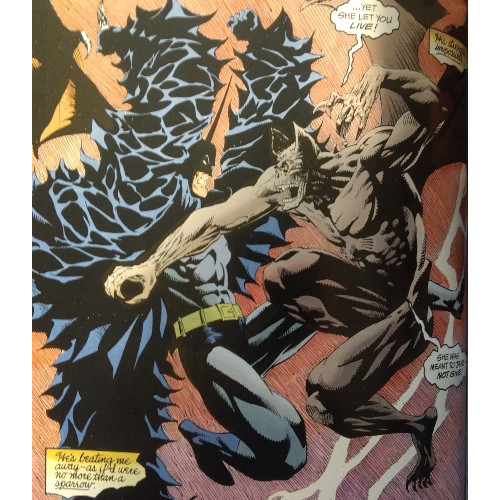
One immediate benefit which elevates this second volume over its predecessor is that Moench and Jones remain the primary creative team on all three one-shots and use all three issues to tell a single story. Each part has a central plot different from the others, but there is an entire narrative told here, emphasized through the brutal transformation of its primary character.
"What If-?" stories always seem to indicate that any change to the main Marvel Universe spells disaster for our heroes. Even changes which start off as hopeful–What if Gwen Stacy lived? What if Dark Phoenix hadn't died?–generally have some pretty gnarly consequences attached. "What if Gotham was plagued by a constant crimson rain and vampires?" doesn't necessarily twist established Batman history and tropes, but it allows for a grim premise to infect these narratives and make you wonder whether our Dark Knight Detective and his assembled cast can stave off these blood-sucking bad guys.
In other words, there's a lot at stake.
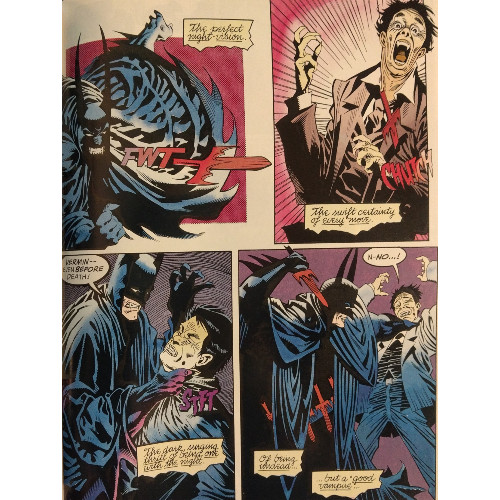
And it's not just for the people of Gotham our Batman fights for but his own soul. Moench and Jones develop in this version of Bruce Wayne a similar yet different creature than we're used to in mainstream comics. Like the mainline DC Universe, this Batman is driven by principles which guide him to take the worst of risks to tackle the foulest of winged abominations. He must become, simultaneously, more than a man and less than human to face the vampires which stalk Gotham–Bruce must embrace a method which allows him greater strength to battle a supernatural threat yet stoops to deplorable methods to prevent the undead and their vampiric overlord from gaining a greater foothold in the city.
It's difficult discussing this without involving spoilers, but the best I can do is offer that Bruce becomes a creature of the night in more ways than just one. He, too, is infected with the same vampirism which afflicts Dracula and his followers, meaning most of his turmoil across the second and third issues involve his constant fight against draining the blood of potential victims. Again, I don't want to reveal too much so as to avoid other major spoilers, but this internal war plagues Bruce almost as much as his mission to eradicate evil. He is a man whose fate, even prior to his transformation, was steeped in violence by the very nature of combating crime. Can he still pursue that purpose without puncturing his enemies' necks and satiating the bloodlust coursing through his veins?

Watching this struggle is the highlight of the volume, and Moench does well to craft a conflict capable of carrying these issues. There is palpable tragedy everywhere you look, whether it's in the loss of allies, the seeming betrayal of others, or the slow, wrenching dissolution of Batman's psyche. Moench casts him in the light of hero and villain alike–we know the importance of Bruce's mission, we know the depths he must sink to (which Moench adequately defends as unavoidable), but we wish for another vein to open up, a different avenue for Bruce to follow. You read, wondering how this incredibly long night could ever end for Bruce. Could a cure be found? Can he hold out on his newly acquired, macabre eating habits and retain some amount of humanity stirring within him?
Interesting as this conflict is, Moench's words find themselves paired with the best possible illustrator for these narratives through Jones. Moench can, admittedly, lean a little too heavily into exposition, occasionally adding a level of redundancy to what Jones develops artistically on the page. As Batman transforms internally across the issues, so does he experience stages of a horrific physical transformation, courtesy of Jones' eerie art. Batman becomes a cross between a man, a bat, a vampire, and some other shambling monstrosity as the volume carries on, Jones depicting him in increasingly inhuman forms. Sharp fangs jutting from exposed gums, a cape billowing like monstrous, ethereal wings (in addition to actual wings), and a protruding spine make this Batman a horrific figure, far outstripping the physical horror of other vampires. The disturbing physicality helps propel the intensity of the narratives–as Batman slides further from physical humanity, allies such as James Gordon and Alfred Pennyworth find themselves more and more desperate to restore Bruce.
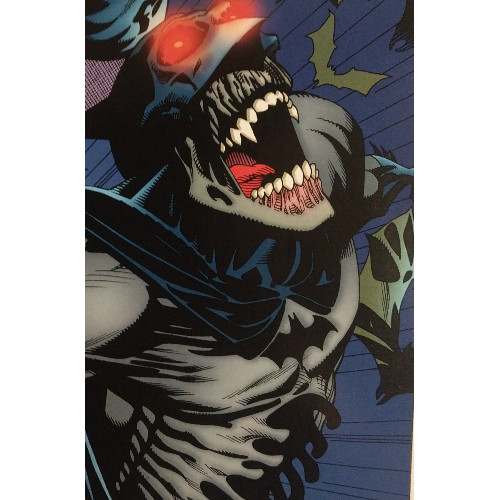
Jones' artwork works wonderfully elsewhere, particularly in the way he details other versions of Batman's rogues gallery. In this universe, Selina Kyle is transformed into a were-cat, purple fur aping her classic purple costume, her own changes mirroring Batman's in a way. Characters like the Joker, Two-Face, Scarecrow, and Killer Croc are drawn into this macabre world, and Jones does not shy away from the lethality of their crimes. Batman may be a monster, but he did not become one by choice, and even as he decays, a line is still developed between him and his ferocious enemies. Jones' work does not look quite as impressive as it could in the third installment, Crimson Mist, but I place the blame on Gregory Wright, who colored the graphic novel digitally. There's something far too clean about how it's presented, which is what you want to avoid when you're dealing with such a messy narrative as this.
I also noted that, in some places, Moench's script can feel a bit bloated. He's a wonder with words, but particularly in Crimson Mist, he spends a few pages in what I would call overindulgent detail. The same concept feels described in several different fashions, and eventually, it feels like Moench is just tossing in what he thinks sounds clever. Moench can certainly be a clever writer, but this section feels like he's trying to do so. Elsewhere, his writing reads well, and when he allows Jones enough creativity to tell the visual side of the story, the combination is smartly done. I'm just not as much a fan of when the words flow like crimson from a pierced jugular.
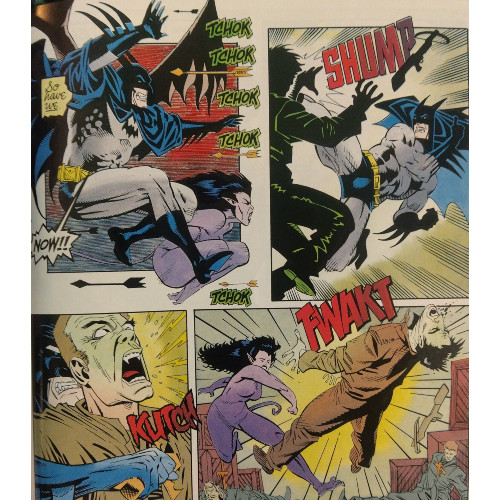
Fortunately, a nip here and a nick there don't drain these graphic novels of their overall vitality. The fact they tell a whole, complete story allows them to stand out from other one-and-done explorations of different worlds. We get a thrilling saga, a trilogy of terror, the tale of a man who becomes something darker and more sinister to battle things even darker and more sinister than he is. "Vampires are real, but not all of them are evil" becomes a sort of mantra across these stories, underscoring the struggle our bloody Batman endures. Just because he becomes a vampire, does that make him evil? Moench and Jones, I believe, want to point to some inherent trait which goes beyond the blood, some nobility which characterizes every Batman, be he a silent guardian, a down-to-earth vigilante, or a winged predator who's exchanged his Batarangs for bat fangs.